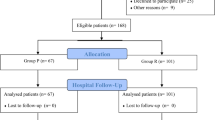Abstract
Objective
To compare postoperative pain perception and analgesia requirements in patients undergoing cesarean section (CS) using general versus spinal anesthesia.
Study design
A prospective, observational study of patients undergoing elective CS during 2009 under either general or spinal anesthesia. Postoperative pain intensity and analgesia requirements were evaluated for up to 48 h after surgery.
Results
A total of 153 women were enrolled; 77 received general and 76 received regional anesthesia. Postoperative meperidine requirements in the first 24 h were significantly higher in the general anesthesia group. Pain scores were mostly comparable between the groups. Nevertheless, lower pain scores were graded after 8 h in the general versus the spinal anesthesia and this reversed at 48 h.
Conclusion
Spinal anesthesia is comparable to general anesthesia in terms of post-operative pain control. In choosing the type of anesthesia in CS, other factors such as the urgency and potential maternal and fetal hazards should be taken into account.
Similar content being viewed by others
References
Lavender T, Hofmeyr GJ, Neilson JP, Kingdon C, Gyte GM (2006) Caesarean section for non-medical reasons at term. Cochrane Database Syst Rev
Martin JA, Hamilton BE, Sutton PD (2005) Births: final data for 2003. Natl Vital Stat Rep 54:1–116
Stamer UM, Wiese R, Stuber F (2005) Change in anaesthetic practice for caesarean section in Germany. Acta Anaesthesiol Scand 49:170–176
Wee MY (2005) The National Institute of Clinical Excellence (NICE) guidelines for caesarean sections: implications for the anaesthetist. Int J Obstet Anesth 14(2):147–158
Jenkins JG, Khan MM (2003) Anesthesia for Caesarean section: a survey in a UK region from 1992 to 2002. Anesthesia 58:1114–1118
Kinsella SM (2008) A prospective audit of regional anaesthesia failure in 5080 caesarean sections. Anaesthesia 63:822–832
Shibli KU, Russell IF (2000) A survey of anaesthetic techniques used for caesarean section in the UK in 1997. Int J Obstet Anesth 9(3):160–167
Hawkins JL, Gibbs CP, Orleans M, Martin-Salvaj G, Beaty B (1997) Obstetric Anesthesia Workforce Survey, 1981 versus 1992. Anesthesiology 87(1):135–143
Afolabi BB, Lesi FE, Merah NA (2006) Regional versus general anaesthesia for caesarean section. Cochrane Database Syst Rev. 18(4)
McKeen DM, George RB, O’Connell CM, Allen VM, Yazer M, Wilson M, Phu TC (2011) Difficult and failed intubation: Incident rates and maternal, obstetrical, and anesthetic predictors. Can J Anaesth 58(6):514–524
Mancuso A, De Vivo A, Giacobbe A, Priola V, Maggio Savasta L, Guzzo M, De Vivo D, Mancuso A (2010) General versus spinal anaesthesia for elective caesarean sections: effects on neonatal short-term outcome. A prospective randomised study. J Matern Fetal Neonatal Med 23(10):1114–1118
Qublan HS, Merhej A, Dabbas MA, Hindawi IM (2001) Spinal versus general anesthesia for elective cesarean delivery: a prospective comparative study. Clin Exp Obstet Gynecol 28(4):246–248
Wang JJ, Ho ST, Liu HS, Tzeng JI, Tze TS, Liaw WJ (1995) The preemptive effect of regional anesthesia on post-cesarean section pain. Acta Anaesthesiol Sin 33(4):211–216
Fassoulaki A, Staikou C, Melemeni A, Kottis G, Petropoulos G (2010) Anaesthesia preference, neuraxial vs. general, and outcome after caesarean section. J Obstet Gynaecol 30(8):818–821
Kessous R, Wiznitzer A, Polachek H, Weintraub AY, Zlotnik A, Pariente G, Aricha-Tamir B, Press F, Leizerovich A, Sheiner E (2011) Preoperative analgesia with local lidocaine infiltration for post-cesarean delivery pain management. J Matern Fetal Neonatal Med
Nguyen NK, Landais A, Barbaryan A, M’barek MA, Benbaghdad Y, McGee K, Lanba P (2010) Analgesic Efficacy of Pfannenstiel Incision Infiltration with Ropivacaine 7.5 mg/mL for Caesarean Section. Anesthesiol Res Pract 10
Bamigboye AA, Hofmeyr GJ (2010) Caesarean section wound infiltration with local anaesthesia for postoperative pain relief—any benefit? S Afr Med J 100(5):313–319
Akhtaruzzaman AK, Banik D, Akhtar MF, Roy J, Haque MF, Hye MA (2010) Prolonged analgesia by adding midazolam and hyperbaric bupivacaine in subarachnoid block for lower uterine caesarian section. Mymensingh Med J 19(4):569–575
Sheiner E, Shoham-Vardi I, Sheiner EK, Press F, Hackmon-Ram R, Mazor M, Katz M (2000) A comparison between the effectiveness of epidural analgesia and parenteral pethidine during labor. Arch Gynecol Obstet 263(3):95–98
Sheiner E, Sheiner EK, Shoham-Vardi I, Gurman GM, Press F, Mazor M, Katz M (2000) Predictors of recommendation and acceptance of intrapartum epidural analgesia. Anesth Analg 90(1):109–113
Sheiner E, Shoham-Vardi I, Ohana E, Segal D, Mazor M, Katz M (1999) Characteristics of parturients who choose to deliver without analgesia. J Psychosom Obstet Gynaecol 20(3):165–169
Carvalho B, Chu L, Fuller A, Cohen SE, Riley ET (2006) Valdecoxib for postoperative pain management after cesarean delivery: a randomized, double-blind, placebo-controlled study. Anesth Analg 103:664–670
Pan PH (2006) Post-cesarean delivery pain management: multimodal approach. Int J Obstet Anesth 15(3):185–188
Ranta PO, Ala-Kokko TI, Kukkonen JE, Ohtonen PP, Raudaskoski TH, Reponen PK, Rawal N (2006) Incisional and epidural analgesia after caesarean delivery: a prospective, placebo-controlled, randomised clinical study. Int J Obstet Anesth 15(3):189–194
Conflict of interest
The authors report no declarations of interest.
Author information
Authors and Affiliations
Corresponding author
Rights and permissions
About this article
Cite this article
Kessous, R., Weintraub, A.Y., Wiznitzer, A. et al. Spinal versus general anesthesia in cesarean sections: the effects on postoperative pain perception. Arch Gynecol Obstet 286, 75–79 (2012). https://doi.org/10.1007/s00404-012-2265-y
Received:
Accepted:
Published:
Issue Date:
DOI: https://doi.org/10.1007/s00404-012-2265-y




